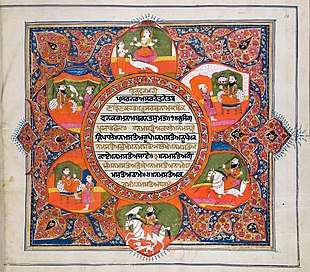Chandi Charitar Ukti Bilas
Chandi Charitar Ukti Bilas or Chandi Charitar Ukat(i) Bilas (Punjabi: ਚੰਡੀ ਚਰਿਤ੍ਰ (ੳਕਤਿ ਬਿਲਾਸ), also called Chandi Charitar 1 is a heroic poetic composition, included in the 4th chapter of Dasam Granth, whose authorship is generally and traditionally attributed to Guru Gobind Singh.[1][2]
| Part of a series on |
| Dasam Granth |
|---|
 |
| Dasam Granth - (ਦਸਮ ਗ੍ਰੰਥ ਸਾਹਿਬ) |
| Banis |
|
| Other Related Banis |
|
| Various aspects |
| Idolatry Prohibition |
Though crew is based on Markandeya Purana, The direction and narration of whole story is totally independent of Markandeya Puran.[3]
Overview
Chandi stands for the embodiment of ferocious "shakti" or the female form of cosmic energy. Bilas comes from vilaas which can also be described as chronicles/descriptive/heroics, Ukati means on, and Charitar means characteristics and function. So, Chandi Charitar Ukti Bilas means "Discussion on characteristics and functions of Chandi".
Ukat(i) bilas is divided into eight cantos, comprises 233 couplets and quatrains, employing seven different metres, with Savaiyya and Dohara predominating. In the former, the source of the story mentioned is Durga Saptasati, which is a portion of Markandeya Purana, from chapters 81 to 94.
The language of the composition is Braj. Ukti Bilas was composed at Anandpur Sahib, before 1698, the year when the Bichitra Natak was completed. The concluding lines of the last canto of Chandi Charitra Ukti Bilas as included in the Dasam Granth manuscript preserved at Patna, however, mention 1752 Bk / AD 1695 as the year of the composition of this work.[4]
There are few more related compositions of Guru Gobind Singh i.e. Chandi Charitar 2 (self-composed but it is said to be based on Devi Bhagwat Puran skandh 5, chapters 2 to 35[4]), Chandi di Var (self-composed), Chandi Charitar - Charitropakhyan - Charitar 1) (self-composed) and Ugardanti (self-composed).
Contents
The bani starts with ੴ ਵਾਹਿਗੁਰੂ ਜੀ ਕੀ ਫਤਹਿ ॥ (The Lord is one and the Victory is of the Lord) and ends with ਇਤਿ ਸ੍ਰੀ੍ਰ ਮਾਰਕੰਡੇ ਪੁਰਾਨੇ ਸ੍ਰੀ ਚੰਡੀ ਚਰਿਤ੍ਰੋ ਉਕਤਿ ਬਿਲਾਸ ਦੇਵ ਸੁਰੇਸ ਸਹਿਤ ਜੈਕਾਰ ਸਬਦ ਕਰਾ ਅਸਟਮੋ ਧਿਆਇ ਸਮਾਪਤਮ ਸਤੁ ਸੁਭਮ ਸਤੁ॥੮॥(End of the Eighth Chapter of Chandi CHaritar Ukati Bilas based on Markandeya Puran, All Deities and their King hailed to Chandi) [5]
In the beginning, the author mentioned attributes of one whom he worshiped:
The Lord is Primal, Infinite, Account less, Boundless, Deathless, Garbless, Incomprehensible and Eternal. He created Siv-Sakti, four Vedas and three modes of maya and Pervades in three worlds. He created day and night, the lamps of sun and moon and the whole world with five elements. He extended enmity and fight between the gods and demons and Himself seated (on His Throne) scans it.1.
— (Chandi Charitar Ukati Bilas, verse 1 to 4)
Definition of Chandi
First Twelve Lines are about Definition of Word Chandi. After this basic explanation Author have explained the Character (Charitar) of Chandi:
Thou Who Ferries across people, Redeemer of Earth and Destroyer of Demons is Chandi.
— (Chandi Charitar Ukati Bilas, verse 9)
Chandi is Light(Joti) shining in the world, which is Blazing, cut Heads, and Shine intensely!
— (Chandi Charitar Ukati Bilas, verse 7)
Chandi is Arm which punishes and destroys Demon and art the Creator of the nine regions.3.
— (Chandi Charitar Ukati Bilas, verse 8)
Chandi means "the violent and impetuous one".[6] In Gurmat, Chandi is attributed to intuitive and discerning mind called Vivek Budhi[7] which fights with negativity. In contrast, Sakar Hindus and the anti-Dasam Granth people[8] portray Chandi as a lady having physical appearance: a combination of Mahakali, Mahalakshmi and Maha Saraswati.
Deh Siva Var Mohe
The most popular Hymns in Sikhism is taken from Chandi Charitar Ukati Bilas,
ਦੇਹ ਸਿਵਾ ਬਰੁ ਮੋਹਿ ਇਹੈ ਸੁਭ ਕਰਮਨ ਤੇ ਕਬਹੂੰ ਨ ਟਰੋਂ ॥
ਨ ਡਰੋਂ ਅਰਿ ਸੋ ਜਬ ਜਾਇ ਲਰੋਂ ਨਿਸਚੈ ਕਰਿ ਅਪੁਨੀ ਜੀਤ ਕਰੋਂ ॥
ਅਰੁ ਸਿਖ ਹੋਂ ਆਪਨੇ ਹੀ ਮਨ ਕੌ ਇਹ ਲਾਲਚ ਹਉ ਗੁਨ ਤਉ ਉਚਰੋਂ ॥
ਜਬ ਆਵ ਕੀ ਅਉਧ ਨਿਦਾਨ ਬਨੈ ਅਤਿ ਹੀ ਰਨ ਮੈ ਤਬ ਜੂਝ ਮਰੋਂ ॥੨੩੧॥ [1]
देह शिवा बर मोहे ईहे, शुभ कर्मन ते कभुं न टरूं
न डरौं अरि सौं जब जाय लड़ौं, निश्चय कर अपनी जीत करौं,
अरु सिख हों आपने ही मन कौ इह लालच हउ गुन तउ उचरों,
जब आव की अउध निदान बनै अति ही रन मै तब जूझ मरों ॥२३१॥
Translation: O Siva (Chandi or Shakti) grant me the boon, that I may never deviate from doing a good deed. That I shall not fear when I go into combat. And with determination I will be victorious. That I may teach myself this greed alone, to learn only Thy praises. And when the last days of my life come, I may die in the might of the battlefield.
References
- Dasam Granth - An Introductory Study
- "Sri Dasam.org - Website contain whole text of dasam granth". Archived from the original on 2011-07-28. Retrieved 2010-12-05.
- Chandi Di Vaar : Jeet Singh Sital
- "Archived copy". Archived from the original on 2011-08-08. Retrieved 2011-07-30.CS1 maint: archived copy as title (link)
- "Sridasam.org - End o Composition". Archived from the original on 2011-07-17. Retrieved 2010-12-09.
- Coburn, Thomas B., Devī Māhātmya. p 95
- Narration by Pro Dasam on Chandi - In Punjabi
- "Archived copy". Archived from the original on 2010-03-30. Retrieved 2010-12-09.CS1 maint: archived copy as title (link)